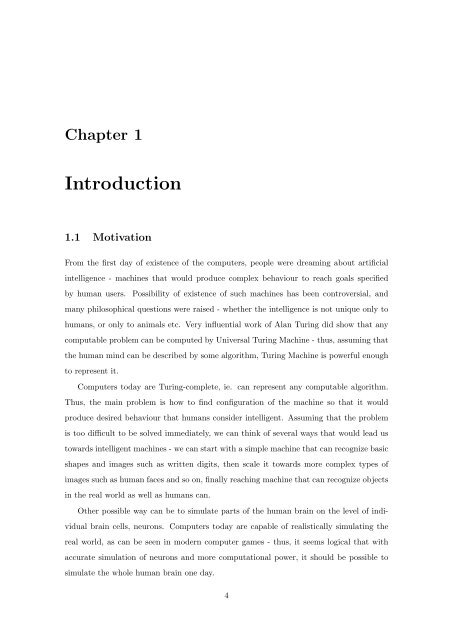Statistical Language Models based on Neural Networks - Faculty of ...
Statistical Language Models based on Neural Networks - Faculty of ...
Statistical Language Models based on Neural Networks - Faculty of ...
You also want an ePaper? Increase the reach of your titles
YUMPU automatically turns print PDFs into web optimized ePapers that Google loves.
Chapter 1<br />
Introducti<strong>on</strong><br />
1.1 Motivati<strong>on</strong><br />
From the first day <strong>of</strong> existence <strong>of</strong> the computers, people were dreaming about artificial<br />
intelligence - machines that would produce complex behaviour to reach goals specified<br />
by human users. Possibility <strong>of</strong> existence <strong>of</strong> such machines has been c<strong>on</strong>troversial, and<br />
many philosophical questi<strong>on</strong>s were raised - whether the intelligence is not unique <strong>on</strong>ly to<br />
humans, or <strong>on</strong>ly to animals etc. Very influential work <strong>of</strong> Alan Turing did show that any<br />
computable problem can be computed by Universal Turing Machine - thus, assuming that<br />
the human mind can be described by some algorithm, Turing Machine is powerful enough<br />
to represent it.<br />
Computers today are Turing-complete, ie. can represent any computable algorithm.<br />
Thus, the main problem is how to find c<strong>on</strong>figurati<strong>on</strong> <strong>of</strong> the machine so that it would<br />
produce desired behaviour that humans c<strong>on</strong>sider intelligent. Assuming that the problem<br />
is too difficult to be solved immediately, we can think <strong>of</strong> several ways that would lead us<br />
towards intelligent machines - we can start with a simple machine that can recognize basic<br />
shapes and images such as written digits, then scale it towards more complex types <strong>of</strong><br />
images such as human faces and so <strong>on</strong>, finally reaching machine that can recognize objects<br />
in the real world as well as humans can.<br />
Other possible way can be to simulate parts <strong>of</strong> the human brain <strong>on</strong> the level <strong>of</strong> indi-<br />
vidual brain cells, neur<strong>on</strong>s. Computers today are capable <strong>of</strong> realistically simulating the<br />
real world, as can be seen in modern computer games - thus, it seems logical that with<br />
accurate simulati<strong>on</strong> <strong>of</strong> neur<strong>on</strong>s and more computati<strong>on</strong>al power, it should be possible to<br />
simulate the whole human brain <strong>on</strong>e day.<br />
4







